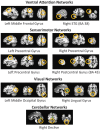Multi-modal, Multi-measure, and Multi-class Discrimination of ADHD with Hierarchical Feature Extraction and Extreme Learning Machine Using Structural and Functional Brain MRI
- PMID: 28420972
- PMCID: PMC5378777
- DOI: 10.3389/fnhum.2017.00157
Multi-modal, Multi-measure, and Multi-class Discrimination of ADHD with Hierarchical Feature Extraction and Extreme Learning Machine Using Structural and Functional Brain MRI
Erratum in
-
Corrigendum: Multi-modal, Multi-measure, and Multi-class Discrimination of ADHD with Hierarchical Feature Extraction and Extreme Learning Machine Using Structural and Functional Brain MRI.Front Hum Neurosci. 2017 May 31;11:292. doi: 10.3389/fnhum.2017.00292. eCollection 2017. Front Hum Neurosci. 2017. PMID: 28579953 Free PMC article.
Abstract
Structural and functional MRI unveil many hidden properties of the human brain. We performed this multi-class classification study on selected subjects from the publically available attention deficit hyperactivity disorder ADHD-200 dataset of patients and healthy children. The dataset has three groups, namely, ADHD inattentive, ADHD combined, and typically developing. We calculated the global averaged functional connectivity maps across the whole cortex to extract anatomical atlas parcellation based features from the resting-state fMRI (rs-fMRI) data and cortical parcellation based features from the structural MRI (sMRI) data. In addition, the preprocessed image volumes from both of these modalities followed an ANOVA analysis separately using all the voxels. This study utilized the average measure from the most significant regions acquired from ANOVA as features for classification in addition to the multi-modal and multi-measure features of structural and functional MRI data. We extracted most discriminative features by hierarchical sparse feature elimination and selection algorithm. These features include cortical thickness, image intensity, volume, cortical thickness standard deviation, surface area, and ANOVA based features respectively. An extreme learning machine performed both the binary and multi-class classifications in comparison with support vector machines. This article reports prediction accuracy of both unimodal and multi-modal features from test data. We achieved 76.190% (p < 0.0001) classification accuracy in multi-class settings as well as 92.857% (p < 0.0001) classification accuracy in binary settings. In addition, we found ANOVA-based significant regions of the brain that also play a vital role in the classification of ADHD. Thus, from a clinical perspective, this multi-modal group analysis approach with multi-measure features may improve the accuracy of the ADHD differential diagnosis.
Keywords: ADHD-200; ANOVA; extreme learning machine; global functional connectivity; hierarchical feature extraction; machine learning; neuroimaging; revised recursive feature elimination.
Figures




Similar articles
-
Multiclass Classification for the Differential Diagnosis on the ADHD Subtypes Using Recursive Feature Elimination and Hierarchical Extreme Learning Machine: Structural MRI Study.PLoS One. 2016 Aug 8;11(8):e0160697. doi: 10.1371/journal.pone.0160697. eCollection 2016. PLoS One. 2016. PMID: 27500640 Free PMC article. Clinical Trial.
-
Corrigendum: Multi-modal, Multi-measure, and Multi-class Discrimination of ADHD with Hierarchical Feature Extraction and Extreme Learning Machine Using Structural and Functional Brain MRI.Front Hum Neurosci. 2017 May 31;11:292. doi: 10.3389/fnhum.2017.00292. eCollection 2017. Front Hum Neurosci. 2017. PMID: 28579953 Free PMC article.
-
Multimodal Discrimination of Schizophrenia Using Hybrid Weighted Feature Concatenation of Brain Functional Connectivity and Anatomical Features with an Extreme Learning Machine.Front Neuroinform. 2017 Sep 8;11:59. doi: 10.3389/fninf.2017.00059. eCollection 2017. Front Neuroinform. 2017. PMID: 28943848 Free PMC article.
-
Machine Learning Techniques for the Diagnosis of Attention-Deficit/Hyperactivity Disorder from Magnetic Resonance Imaging: A Concise Review.Neurol India. 2021 Nov-Dec;69(6):1518-1523. doi: 10.4103/0028-3886.333520. Neurol India. 2021. PMID: 34979636 Review.
-
A Systematic Review of Imaging Studies in the Combined and Inattentive Subtypes of Attention Deficit Hyperactivity Disorder.Front Integr Neurosci. 2020 Jun 24;14:31. doi: 10.3389/fnint.2020.00031. eCollection 2020. Front Integr Neurosci. 2020. PMID: 32670028 Free PMC article.
Cited by
-
Hybrid multivariate pattern analysis combined with extreme learning machine for Alzheimer's dementia diagnosis using multi-measure rs-fMRI spatial patterns.PLoS One. 2019 Feb 22;14(2):e0212582. doi: 10.1371/journal.pone.0212582. eCollection 2019. PLoS One. 2019. PMID: 30794629 Free PMC article.
-
Sampling inequalities affect generalization of neuroimaging-based diagnostic classifiers in psychiatry.BMC Med. 2023 Jul 3;21(1):241. doi: 10.1186/s12916-023-02941-4. BMC Med. 2023. PMID: 37400814 Free PMC article.
-
Classification Accuracy of Neuroimaging Biomarkers in Attention-Deficit/Hyperactivity Disorder: Effects of Sample Size and Circular Analysis.Biol Psychiatry Cogn Neurosci Neuroimaging. 2019 Feb;4(2):108-120. doi: 10.1016/j.bpsc.2018.06.003. Epub 2018 Jun 27. Biol Psychiatry Cogn Neurosci Neuroimaging. 2019. PMID: 30064848 Free PMC article.
-
Resting state EEG assisted imagined vowel phonemes recognition by native and non-native speakers using brain connectivity measures.Phys Eng Sci Med. 2024 Sep;47(3):939-954. doi: 10.1007/s13246-024-01417-w. Epub 2024 Apr 22. Phys Eng Sci Med. 2024. PMID: 38647635
-
Multimodal Sparse Classifier for Adolescent Brain Age Prediction.IEEE J Biomed Health Inform. 2020 Feb;24(2):336-344. doi: 10.1109/JBHI.2019.2925710. Epub 2019 Jun 28. IEEE J Biomed Health Inform. 2020. PMID: 31265424 Free PMC article.
References
-
- Association AP (2013). Diagnostic and Statistical Manual of Mental Disorders. Washington, DC: APA.
LinkOut - more resources
Full Text Sources
Other Literature Sources

